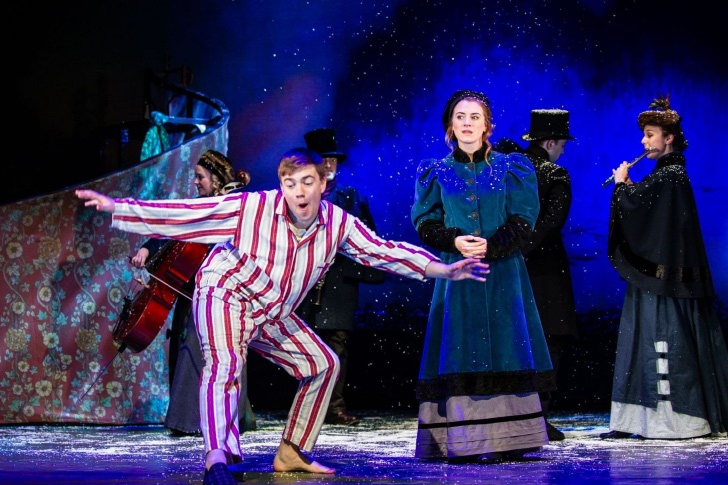|
Food for
young imaginations

Tom’s midnight garden
Coventry Belgrade
****
IF
youngsters are in danger of becoming too used to special effects and
Computer Generated Imagery, which all too often are more memorable than
the story, then this is the perfect antidote.
This
Birmingham Stage Company production is a workout for the imagination,
that most powerful special effect of all, and what a treat it is.
Philippa Pearce’s 1958 novel
has provided a strong story laced with ghosts and metaphysical dilemmas
about time and space, which has been adapted for the stage by legendary
children’s dramatist David Wood.
Then director Neal Foster and
designer Jacqueline Trousdale provide the basics of the tale on stage,
more than enough to grab the audience’s attention but still demanding
imagination to complete the picture whether it be gardener Abel’s
imaginary tools or a skate along the river to Ely cathedral and the
climb up its tower.
The story is deceptively
simple. Tom, played by David Tute, is sent to his aunt and uncle, Gwen
and Alan, (Kate Adams and Tom Jude, who also plays Abel) after brother
Peter (Ed Thorpe) catches measles.
The old house has an old
grandfather clock which keeps excellent time although its chimes are
more in the think of a number category – except at midnight when
the clock strikes 13, thirteen o’clock when time no longer has meaning
and a door out to the yard and dustbins becomes the gateway to the
midnight garden of the title.
Set in the 1950s Tom finds
himself living in a flat in a rambling old house which is owned by a
rather stern and strict Mrs Bartholomew, played by Helen Ryan. It has no
garden, not that that matters as Tom is not allowed out as he may be
infectious and his aunt and uncle don’t want to spread measles.
So he is in quarantine with no
friends of his own age to play with and nothing to do until he finds the
magic gateway, which takes him back to the house as it was, and indeed
still is on the other side of the door, at the end of the 19th
century in the reign of Queen Victoria.
There he meets Hatty, another
lonely child, played by Caitlin Thorburn, and the pair, even in the few
short days Tom is with his aunt and uncle, grow up together.
STRICT AND CRUEL
She can see him, as can Abel,
but her strict and cruel aunt Grace (Ryan again) is in the dark as are
her three sons, Hatty’s cousins, James (Ifan Gwilym-Jones) who likes
her, Edgar (Ed Thorpe) who doesn’t and Hubert (Joe Stuckey) who couldn’t
care less about her.
Time has no meaning. Tom,
still a little boy, meets the man Hatty, now a young woman, is
eventually to marry, Barty, Gwilym-Jones again while she meets brother
Peter, who we know should be ill, at home, with measles.
In magic, time is fluid, not a
constant. On his side of the grandfather clock Tom is visiting nightly,
on Hatty’s side his visits are coming months and even years apart as she
grows from little girl to young woman.
It is not an easy concept to
take in, or perhaps as adults we analyse too much while children just
accept that logic has no place in magic, magic is just . . . well magic.
My three-year-old grandson
never questioned the time and space elements as he sat enthralled in
silence from beginning to end – to him the little girl and the old lady
being one and the same was just the way it was. That was the story. How
or why did not matter.
Mind you we had many whys on
other matters in the car on the way home though, such as why Hatty fell
from a tree or why Tom was crying as he tried to vist the garden one
last time.
He has reached that age when a
simple why is a sort of logic grenade. An answer is followed by another
why followed by another, and another until you reach a point where you
either have to reveal the secret of the universe or admit you don’t know
– and even that usually elicits another why.
Children are . . . just
different and that brings us back to Tom and friends with the actors
playing Tom, Hatty, and her three cousins, managing the by no means easy
task of adults pretending to be youngsters with some considerable skill.
Add to that the fact that the
cast also had to provide an onstage orchestra and BSC has managed to put
together a very talented ensemble.
The final scene as Tom talks
to Mrs Bartholomew provides us with more questions than answers such as
who was the real ghost, was it Tom from the future, or Hatty from the
past – and shouldn’t ghosts be of people who are dead?
If it was all a dream, whose
dream was it – Tom’s or Hatty’s? Which sounds like an exam question . .
. discuss.
The fantasy element is helped
by a clever set of scrims, gauze walls which can appear solid or become
invisible with clever lighting from Jason Taylor to give us a
greenhouse, a tree house, Ely cathedral tower, a house both now and then
and a garden which vanished long ago.
All the ingredients are there.
Just add imagination and stir. To 19-04-14
Roger Clarke
17-04-14
|

